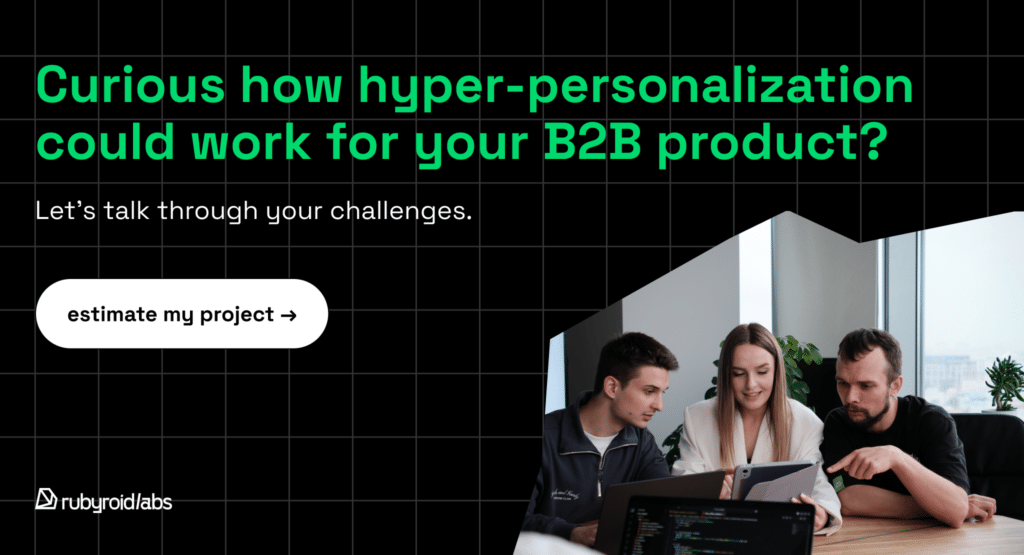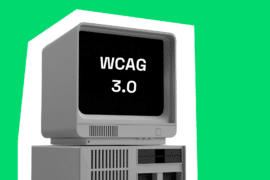TL;DR — What You’ll Learn
How hyper-personalization differs from traditional methods, which technologies power it, why B2B companies are embracing it, and how it’s reshaping the designer’s role.
Using a first name in emails, suggesting products based on previous purchases, and grouping offers by geography or age are examples of personalization, which has long been a mainstay of digital marketing.
Nowadays, in addition to recognizing who they are, users anticipate that brands will also recognize what they are doing, what they are likely to do in the future, and what is most important to them at that particular moment. Therefore, we are seeing a trend towards hyper-personalization now.
As Rubyroid Labs provides user experience design services, we closely monitor B2B user interface trends through client requests, market research, and day-to-day design work. And we’re seeing that more companies are looking for ways to make their interfaces smarter and more responsive to individual users.
That’s why in this article, we’re exploring why hyper-personalization is becoming a priority, what makes it possible today, and how B2B product teams can prepare for the changes ahead.
Contents
- Personalization & Hyper-Personalization: What’s the Difference?
- What Makes Hyper-Personalization Possible Today?
- Why Is Hyper-Personalization Becoming a Priority for B2B Companies?
- How Interfaces (and the Role of the Designer) Are About to Change
- B2B Interfaces That Reflect the Hyper‑Personalization Future
- 3 Reasons Why B2B Products Need Hyper-Personal Interfaces
- Conclusion
Personalization & Hyper-Personalization: What’s the Difference?
UX personalization, in its traditional form, relies on relatively simple user data: names, locations, age groups, past purchases, and declared preferences. It offers product recommendations based on browsing history, emails with your first name in the greeting, or discounts aligned with your birthday month. These rules, which are often static and segment-driven, group users by a few fixed characteristics and serve content accordingly.
Hyper-personalization uses a much wider range of data points, many of which are gathered in real time during each user session. Rather than showing everyone in the same demographic the same interface, it dynamically adjusts the entire experience based on individual behavior, context, and intent. The system learns from a user’s past actions to predict what they are likely to do next, and updates the interface accordingly to reflect those insights.
The data necessary for hyper-personalized UX is broader and deeper. Alongside classic attributes, it tracks how often a user visits, how long they stay on certain pages, and how they move through a site. Click patterns, scroll depth, and time spent on product cards help determine what actually catches their attention.
Purchase behavior is also analyzed through payment method, cart abandonments, and post-purchase reviews. Session-level data such as what a user searches for, which filters they apply, and how they interact with support or email campaigns feeds into the same profile. The system considers external factors, including competitor offerings and industry trends, when determining what content or pricing to display, and uses this personalization logic to update the design in real time.
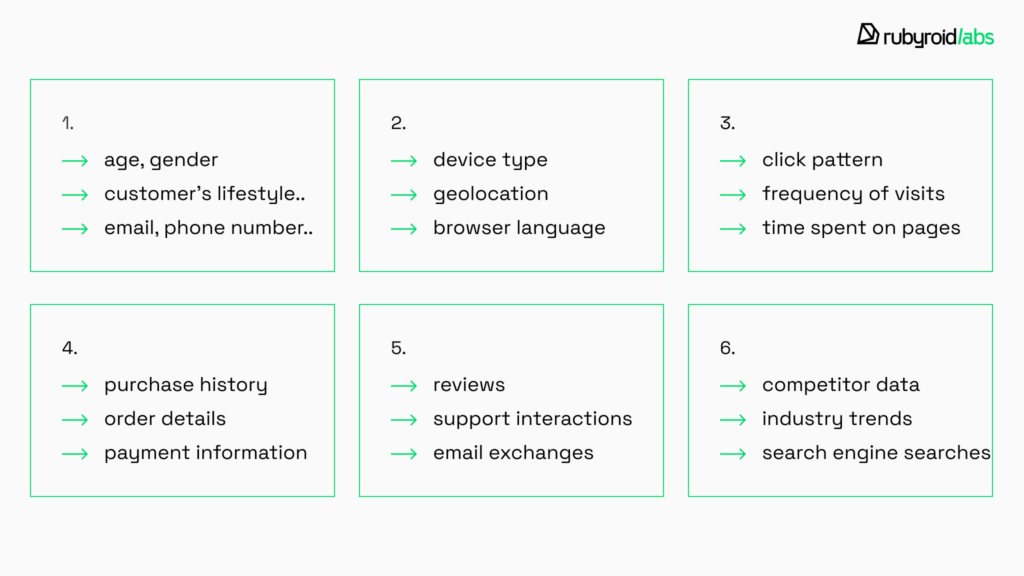
Traditional UX personalization updates slowly, often on a campaign schedule. Hyper-personalized UX operates in real time. In hyper-personalized systems a returning user might see a different homepage layout than they did yesterday, because their current behavior signals a new intent. These shifts are reflected not only in content, but also in interface structure, layout, and component visibility.

What Makes Hyper-Personalization Possible Today?
At the heart of hyper-personalized UX lies data, lots of it. What turns this raw data into actionable insight is machine learning. Unlike rule-based systems, AI-driven user experience models recognize patterns across millions of user interactions and continuously refine predictions.
When a user starts browsing winter jackets on a mobile device in Boston at 7 a.m. (likely in a rush and cold), the model considers location, product type, current temperature, time of day, preferred brands, and past on-site behavior. This data helps determine what content to show, how to prioritize recommendations, and whether to offer a promotion or size filter up front. These decisions influence how the interface behaves and adapts.
That same user in Miami might trigger an entirely different response (even with a similar browsing history) because the model weighs contextual relevance above surface similarity. Predictive analytics, by analyzing historical behavior across millions of interactions, can surface what a user is likely to need before they ask for it.
What makes hyper-personalized interfaces possible now, rather than five years ago, is a combination of factors:
- increased data availability;
- faster model training due to enhanced computational infrastructure;
- more available APIs for AI services;
- growing consumer tolerance for tailored experiences.
There is no need for companies to develop complex in-house engines. Nowadays, they may fine-tune pre-trained models to fit their specific domain, regardless of whether it is retail or B2B SaaS. This evolution marks a new chapter in user experience design.
Why Is Hyper-Personalization Becoming a Priority for B2B Companies?
The shift towards hyper-personalized UX and interfaces is being accelerated by technology as much as by expectations. And it’s not confined to B2C.
By 2027, hyper-personalization will be standard practice across enterprise and B2B environments. Why? Because employees are also users. They’ve come to expect the same tailored, efficient user experiences at work that they enjoy as consumers.
This shift is also commercially driven. Recommendation systems have matured into core revenue levers, and businesses are treating them accordingly. The global content recommendation engine market is projected to grow from $6.15 billion in 2025 to $26.21 billion by 2030. Large enterprises are driving this growth, but small and midsize companies are adopting UX personalization tools faster, with a projected CAGR of 36.8% through 2030.
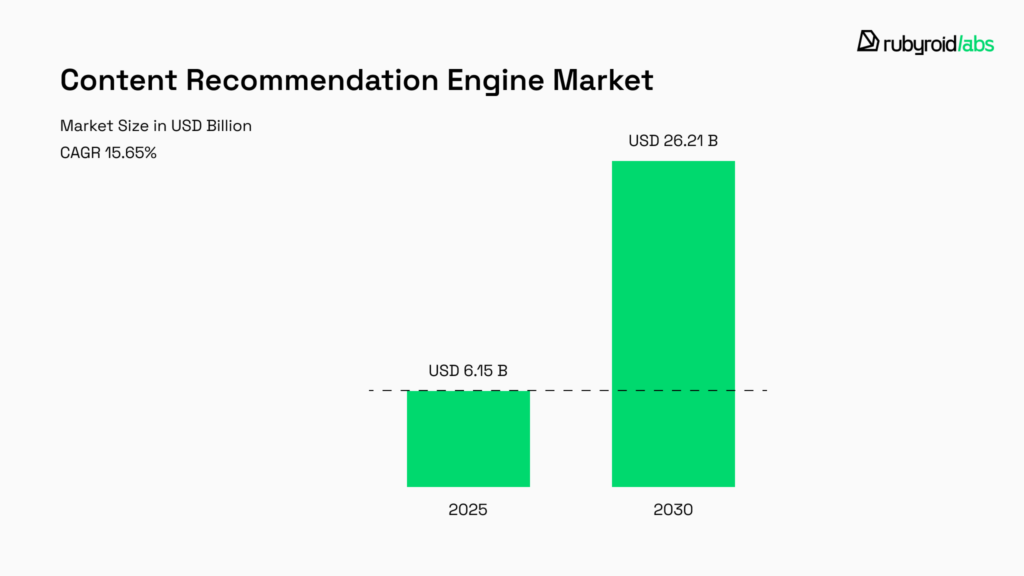
Netflix’s migration to foundation models is a prime example of how streaming platforms are reshaping personalization architecture. B2B software platforms, especially in SaaS and fintech, are starting to mirror this user experience sophistication. AI-driven engines now adjust product layouts, recommend next-best actions, and trigger email or in-app messaging based on live user data.
Another key driver of hyper-personalization is the regulatory environment. Regulations are becoming stricter and third-party cookies are being phased out. So, data-driven interface design increasingly relies on first-party data collected directly from interactions and stored in consent-based environments. Companies now build privacy-aware infrastructures where algorithms train locally (using federated learning), user identities remain protected, and analytics remain powerful without compromising compliance.
How Interfaces (and the Role of the Designer) Are About to Change
Hyper-personalization changes the role of the interface and with it, the role of the designer. Traditionally, B2B UX teams create standardized user flows to guide users through predefined paths. Hyper-personalized UX must adapt in real time.
One of the clearest explanations of this shift comes from user experience expert Jakob Nielsen, who wrote:
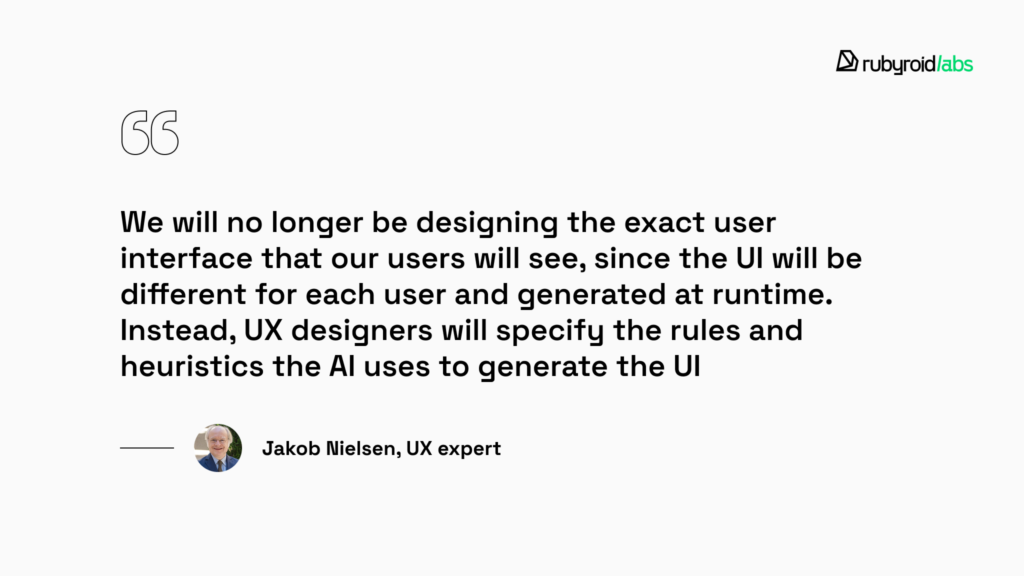
Once user experiences become adaptive, interfaces stop being stable. Under this new paradigm, designers establish guidelines for what can be displayed. There will be thousands of versions of the same user interface, each triggered by a different combination. Elements like buttons, forms, and filters will no longer be fixed. Depending on the circumstance, they will be put together, modified, or omitted completely.
And hyper-personalization is not the only trend that is reshaping our concept of interface. Touchless interaction is also becoming more popular. We explore this topic in more detail in the article How Voice and Gesture-Based Interfaces Are Reshaping UI/UX.
Our understanding of personas and journeys will also need to expand. Instead of wireframes and fixed interfaces, designers will be building scenario maps, personalization tiers, fallback states, and dynamic UI/UX templates. There will be more documentation, more user research, and closer collaboration with engineers. Designers will need to understand what data the system has access to, how it’s gathered, how often it’s updated, and how sensitive it is.
Moreover, designers will need to rethink consistency. Today’s users rely on familiar patterns (menus in the top right, checkout buttons at the bottom). Generative UIs create different experiences for each session or user, so this predictability could disappear. Designers will face the challenge of maintaining usability in an interface that never looks the same twice.
For teams designing complex enterprise platforms, that shift brings new challenges and demands a fresh set of strategies, which we explore in our article Key Aspects of UX/UI Design for Enterprise Applications. This is particularly relevant for SaaS UX strategy, custom UX in enterprise software, and designing personalized B2B interfaces.
Recommendations from Our Design Team
- Learn to work with data. To design for hyper-personalized UX, get familiar with how systems interpret and use data. Focus on clustering, behavioral tracking, recommender systems, and natural language processing. This will help you to design interfaces that fit with the logic behind dynamic personalization.
- Adopt a modular design approach. Focus on building reusable components (cards, buttons, widgets) that the system can assemble based on context. Each component should function independently and work in different combinations.
- Work closely with developers. Understanding the frontend enables you to comprehend what may be rendered dynamically and to deconstruct layouts into reusable user interface components. Knowledge of the backend helps you understand how data is supplied, saved, and queried, all of which have an impact on what can be customized in real time.
- Strengthen your understanding of human psychology. Spend more time studying user motivation, cognitive load, and decision-making patterns. Hyper-personalized systems rely on behavioral cues, so designers need a stronger grasp of how users think, act, and respond in different contexts.
B2B Interfaces That Reflect the Hyper‑Personalization Future
Some enterprise platforms are already adopting key elements of AI-driven user experience in their B2B UIs. We’ve gathered three illustrative examples.
#1 InfyMe
Infosys’ employee-facing intranet, InfyMe, stands out as a pioneering example of adaptive, hyper-personalized UX in B2B. In 2023 it received the prestigious Intranet Design Annual Award from the Nielsen Norman Group, recognized for its AI-powered personalization, dynamic content delivery, and scalable design system.
What Makes It Hyper-Personalized
InfyMe dynamically adjusts its role-based dashboards based on each employee’s role, region, ongoing tasks, and engagement history. Widgets such as HR announcements, IT ticket counts, business news, or reminders appear based on user profile and real-time activity. The layout itself reshuffles to surface the most contextually relevant tools and content.
What Data Is Driving It
The platform synthesizes roles and departments, assigned assets, ticket or workflow history, search input, article/document interaction, and declared interest or community membership. ML models also infer frequently visited modules or recurring workflows, and dynamically optimize the homepage structure.
#2 MyNow
ServiceNow is transitioning its employee portal into a hyper-personalized hub MyNow, powered by generative AI and machine learning. The platform builds composite profiles based on roles, departments, locations, tenure, assigned assets (e.g., laptops), ticket histories, searches, and content interactions. Based on this information it surfaces dynamic widgets and content modules.
What Makes It Hyper-Personalized
The interface layout changes per user. HR tasks, open tickets, approvals, news feed and shortcuts are prioritized based on profile, behavior, and predicted intent. Machine learning drives recommendations for knowledge articles, internal apps, or processes personalized to each employee.
What Data Is Driving It
Profile metadata, ticketing activity, document/library interactions, search queries, time-sensitive events (e.g. open enrollment deadlines), and personalization settings like topics of interest or subscribed community forums.
#3 PwC’s AI‑Driven Intranet
At PwC, UX personalization is built into the employee intranet via the “My Interests” feature, which allows staff to select topics such as well-being, learning, or rewards. That input is combined with behavior and role to generate a personalized “My News” feed. Newsletters are similarly customized using AI tools, driving consistent open rates of 60–70% in a 75,000-employee organization.
What Makes It Hyper-Personalized
Personalized content feeds, curated recommendations, and segmented messaging based on employee interests and behavior patterns.
What Data Is Driving It
Declared preferences (My Interests), search and content interactions, internal engagement signals, and AI-generated content templates.
Check your app’s interface with our UI/UX design audit, and we’ll show you key areas for growth to achieve higher engagement and smoother user interactions.
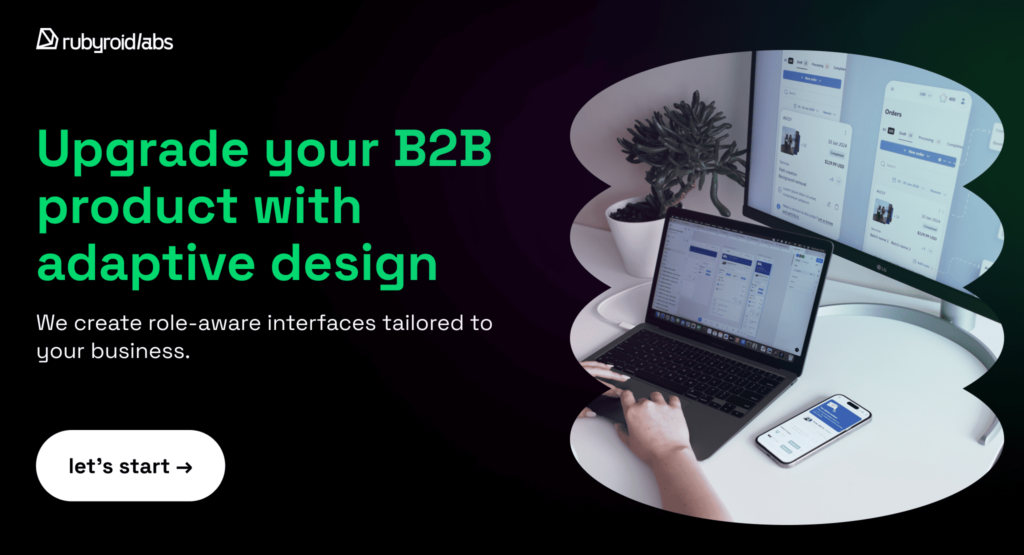
3 Reasons Why B2B Products Need Hyper-Personal Interfaces
It’s easy to postpone change when your current user experience “still works”. But look closer at where the industry is headed, the status quo won’t hold for much longer.
If you’re still on the fence about rethinking your product’s user experience, we’ve highlighted three reasons why you should move towards hyper-personalization.
#1 B2B Users Expect Consumer-Grade Personalization
Today’s B2B buyers are the same individuals who see hyper-personalized UX in their everyday lives. They’ve come to expect the same level of tailored experiences in their professional tools.
According to an online survey by Epsilon, 80% of business customers are more likely to engage with companies that offer personalized experiences.
#2 Long-Term Relationships Demand Customization
The average B2B deal size is higher and the customer lifecycle is much longer than in B2C. Customizing the experience for specific roles and industries pays off in long-term loyalty and higher lifetime value.
Enterprise consumers are more likely to incorporate a product deeply into their operations and stick with it over time when they believe it genuinely “gets” their domain-specific demands.
#3 Early Movers Will Dominate the Market
The future of B2B UX lies in hyper-personalization, and we’re only at the beginning of that curve. That means the companies that act now will position themselves as forward-thinking leaders in their category.
Your team will have more time to experiment, get feedback, and create a competitive moat by 2027 if you invest in hyper-personalized B2B interfaces now. By the time it becomes standard practice, your company will already have years of insight, experience, and user trust.
Conclusion
Unlike traditional personalization, which groups users into segments and serves them static content, hyper-personalization draws from data, behavioral patterns, contextual cues, and predictive models to shape interfaces that respond to each individual user’s needs.
This shift is made possible by three converging forces:
- explosion of available user data;
- growing availability of pre-trained AI model;
- the rise of plug-and-play personalization infrastructure.
But the real driver of change is buyer. B2B buyers now expect the same intuitive user experiences they encounter as consumers.
For designers, this means rethinking the idea of a “single interface”. In hyper-personalized systems, the same user interface will exist in hundreds of variations, each brought on by a distinct combination. It requires readiness to work with large volumes of data.
Hyper-personalized UX in B2B is still in its early stages. This strategy will be commonplace by 2027. We recommend adopting it early to build user trust, gain practical experience, and collect valuable insights before it becomes the norm.
